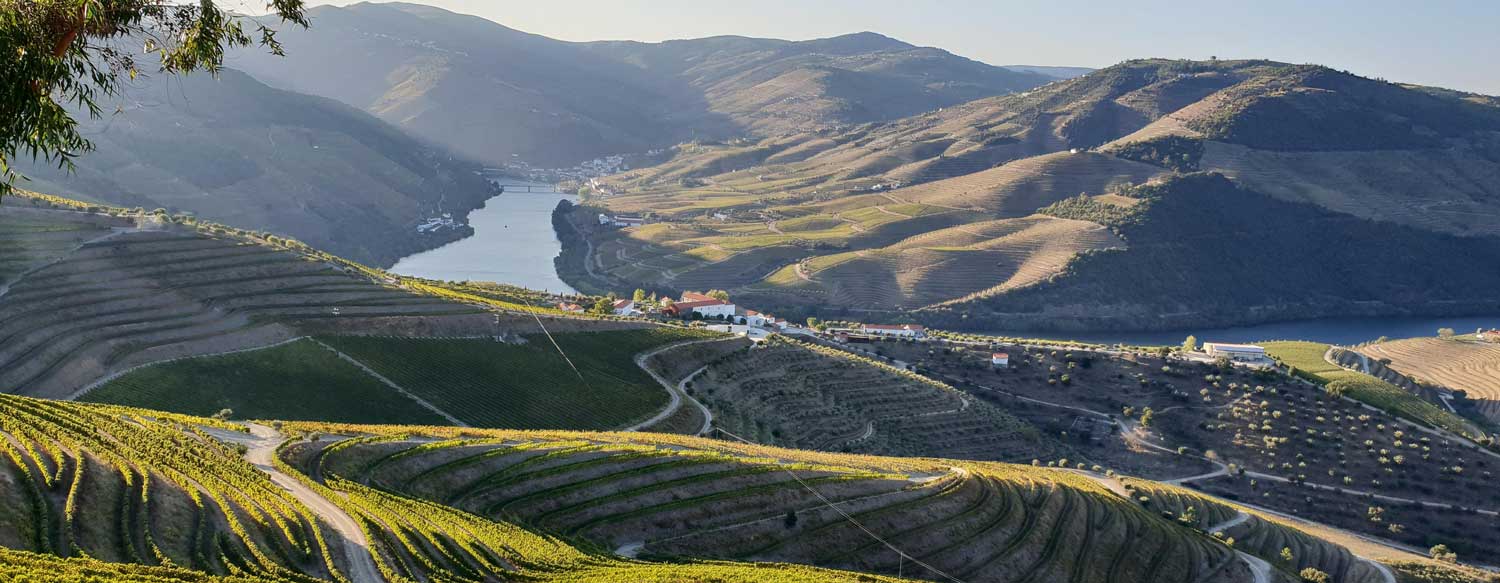
Author: Randy Hamilton
Originally Published in Coastal Palate Magazine, June 2023
Portugal has been known for its wine for centuries. However, it has recently gained popularity among U.S. wine enthusiasts as a spectacular wine region that provides great value for money. Portugal’s wine regions are scattered throughout the country, but the most prominent ones are Vinho Verde, Douro, and Dão. The country also offers diverse and dynamic foods as varied as their wines. There is so much variety packed into a relatively small country that one can spend months vacationing, trying new wines, foods, and destinations.
Traversing the country from North to South, the first wine region one comes across is Vinho Verde. This part of Portugal is a land of stunning natural beauty, with verdant forests, majestic mountains, and winding rivers that cut through the rugged terrain. The Vinho Verde region is often compared to Ireland for its similarly green and lush landscapes, which are dotted with small villages and charming towns. Vinho Verde offers visitors a chance to escape the hustle and bustle of modern life and immerse themselves in the tranquility and charm of rural living.
The Vinho Verde white wine, made from a blend of grapes including the Alvarinho grape, is a unique wine that is perfect for a lazy afternoon on its own or for pairing with numerous foods. The wine gets its name from the fact that it is made from grapes that are picked early when they are still green or “verde” in Portuguese. This gives the wine its signature acidity and lightness and is often imbued with a slight effervescence.
When it comes to food pairings, Vinho Verde is a versatile wine that pairs well with a variety of dishes. It is particularly well-suited for seafood dishes as the wine’s sharp acidity can cut through the richness of the seafood. Portuguese salted cod, or “bacalhau” in Portuguese, is a beloved ingredient in Portugal. Its origins can be traced back centuries to when sailors would salt and dry cod fish in order to have a source of food for their long oceanic journeys. Today, salted cod is still a staple ingredient in many Portuguese dishes, especially deep-fried croquettes that are perfect to be served with a chilled Vinho Verde. Additionally, since the acid in Vinho Verde wines is so high, it can cut the heat in spicy dishes and sauces. So feel free to douse your croquettes with a Portuguese piri-piri hot sauce. This ability to tame spices also makes this wine an ideal match for Cajun seafood dishes.
The next stop on this southward exploration of Portugal is the legendary Douro Valley. The region’s vineyards are nothing short of breathtaking, as they cling precariously to the hillsides, forming a network of terraces that snake along the winding Douro River. Walking through these vineyards is a daunting but exhilarating experience, as you take in the awe-inspiring beauty of the region while admiring the incredible craftsmanship of the viticulturists who have built and maintained these terraces for centuries. There are excellent white and red dry wines, but ultimately this is the land of Port wine. Legend has it that when the English struggled to get through a trade agreement with Portugal, they discovered the pleasures of port wine. Suddenly, the negotiations went much more smoothly!
Port wine can be somewhat of an enigma to many people, even for seasoned wine drinkers because it has so many styles and an extensive range of prices. One thing that is certain is that it goes well by itself or as an accompaniment to a sweet treat. When it comes to sweet treats for dessert or for that matter, any time of the day, the pastéis de nata (pastel de nata in the singular—but who stops at just one?) reign supreme in this area of the world. These goodies go great with any port with a little sweetness to it. I prefer a tawny port that is a little less sweet to go with these pastries as they are not overly sweet, and the puff pastry has a little bit of savoriness to it. Ask anyone who has spent any time in Portugal and I bet they tried the pastéis de nata and they loved them.
Moving about a hundred miles further south we venture into the Dão region located in central Portugal, just northwest of Lisbon. The Dao region has renowned red blended wines that are primarily produced using the indigenous Tinta Roriz grape (also known as Tempranillo in Spain) and the Touriga Nacional grape. Pork dishes are a specialty of this central portion of Portugal and pair well with the Dão red wines. One classic Portuguese pork dish is carne de porco à Alentejana, which consists of marinated pork cubes braised with onion, garlic, tomatoes, sweet peppers, piri-piri sauce, and clams.
For the soup course or a standalone meal, the famous fish stew from Portugal’s most southern region, the Algarve, Cataplana makes an excellent choice. This dish is cooked in a clam-shaped copper or steel pan, also called a cataplana, which seals in all the flavors and aromas of the ingredients. The fresh seafood, tangy tomatoes, and spicy sausage blend perfectly together in this dish. To elevate the flavors I suggest the sparkling red wine, Baga Espumante, from the Bairrada wine region just south of the Duoro, made using the unique grape variety, Baga, as the perfect pairing. Baga is a dark-skinned grape naturally high in acidity, creating a tart sparkler that holds up to the bold flavors of the Cataplana stew.
The wines of Portugal are well suited to the cuisine and culture of the Northern Gulf Coast. There seems to be a Portuguese wine perfect for any setting. Whether enjoying a beautiful day at the beach or indulging in a variety of our local foods such as Cajun-inspired seafood dishes and sausages. A Portuguese wine will always enhance the experience.
Speaking of beach days, be sure to include on your list of summer drinks for fun in the sun, the ever-popular Sangria. While similar to the Sangria in Spain, Portuguese Sangria is primarily made from only red wine and it often includes a splash of brandy. The wine used is usually a young and fruity red, and the fruit used in the mix can vary but commonly includes oranges, lemons, and apples. Some recipes also call for the addition of cinnamon or other spices. The resulting drink is fruity, refreshing, and perfect for sipping on a warm summer day at the beach. It is a quintessential Portuguese drink and cannot be left out of any conversation involving Portuguese culinary culture.
Another Portuguese drink that needs to be mentioned when talking about perfect summer drinks is the Porto Tonico with part of its allure being simplicity. It is a white port served with twice that amount of tonic water, add in a sprig of mint and an orange wedge and you have a lightly sweet and refreshing cocktail to sip on while you figure out your plans for the evening ahead while the sun slowly sets over the horizon.
